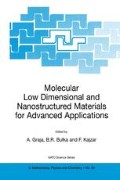Abstract
A scheme of an optically controlled current switch is put forward, based on properties of a conducting polymer containing photochromic moieties chemically attached to the main chain. On the basis of electrostatic interactions of charge carriers with dipoles of the side groups, new local electron states are formed in the vicinity of the polar centres and on-chain charge carrier mobility is reduced. The idea is supported with measurements of the drift mobilities in polysilane copolymers containing polar benzaldehyde 2,4-dinitrophenylhydrazone groups.
Access this chapter
Tax calculation will be finalised at checkout
Purchases are for personal use only
Preview
Unable to display preview. Download preview PDF.
References
Bao, Z., Lovinger, A.J., and Dodabalapur A. (1996) Organic field-effect transistors with high mobility based on copper phthalocyanine, Appl. Phys. Lett. 69, 3066–3068.
Horowitz, G., Hajlaoui, R., Bouchriha, H., Bourguiga, R., and Hajlaoui, M. (1998) The concept of “treshold voltage” in organic field-effect transistors, Adv. Mater. 10, 923–927.
Carter F.L. (1982) Conformational switching at the molecular level, in: F. L. Carter (Ed.) Molecular Electronic Devices, M. Dekker, New York, pp. 51–71.
Miller, R.D. and Michl, J. (1989) Polysilane high polymers, Chem. Rev., 89, 1359–1410.
Sworakowski, J. and Nešpurek, S. (2001) Dipolar species in molecular materials: towards modulation of charge carrier mobilities by electrostatic interactions, these Proceedings.
Nešpurek, S., Sworakowski, J., and Kadashchuk, A. (2001) The influence of dipolar species on charge carrier transport in a linear polysilicon, IEEE Trans. Diel. Electr. Insul. 8, 432–441.
Chu, N.Y.C. (1990) Spirooxazines, in: H. Dürr and H. Bouas-Laurent (Eds.), Photochromism, Elsevier, Amsterdam, pp. 879–882.
Guglielmetti, R. (1990) 4n+2 Systems: spiropyrans, in: H. Dürr and H. Bouas-Laurent (Eds.), Photochromism, Elsevier, Amsterdam, pp. 314–466.
Rau, H. (1990) Azo compounds, in: H. Dürr and H. Bouas-Laurent (Eds.), Photochromism, Elsevier, Amsterdam, pp. 165–192.
Haddon, R.C. and Stillinger, F. H. (1982) Molecular memory and hydrogen bonding, in: F. L. Carter (Ed.) Molecular Electronic Devices, M. Dekker, New York, pp. 19–30.
Nešpurek, S., Valerián, H., Eckhardt, A., Herden, V., and Schnabel, W., (2001) Charge carrier transport inpoly[methyl(phenyl)silylene]: the effect of additives, Polym. Adv. Technol., 12, 306–318.
Nešpurek, S., Pfleger, J., Brynda, E., Kmínek, I., Kadashchuk, A., Vakhin, A., and Sworakowski, J. (2001) Poly(silylene)s: Effect of polar acceptor side groups on the charge carrier photodegradation and transport. Mol. Cryst. Liq. Cryst. 355, 191–216.
Bässler, H. (1993) Charge transport in disordered organic photoconductors. A Monte Carlo simulation study, Phys. Stat. Sol. (b) 175, 15.
Author information
Authors and Affiliations
Editor information
Editors and Affiliations
Rights and permissions
Copyright information
© 2002 Springer Science+Business Media Dordrecht
About this chapter
Cite this chapter
Nešpůrek, S., Toman, P., Sworakowski, J., Lipiński, J. (2002). Photochromic Molecules as Control Units in Molecular Switches. In: Graja, A., Bułka, B.R., Kajzar, F. (eds) Molecular Low Dimensional and Nanostructured Materials for Advanced Applications. NATO Science Series, vol 59. Springer, Dordrecht. https://doi.org/10.1007/978-94-010-0349-0_4
Download citation
DOI: https://doi.org/10.1007/978-94-010-0349-0_4
Publisher Name: Springer, Dordrecht
Print ISBN: 978-1-4020-0578-7
Online ISBN: 978-94-010-0349-0
eBook Packages: Springer Book Archive

